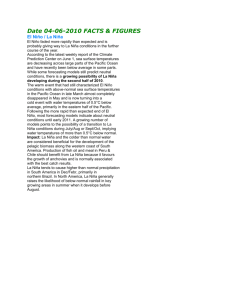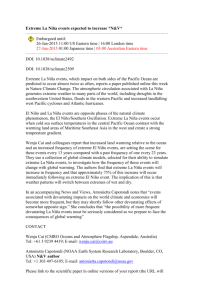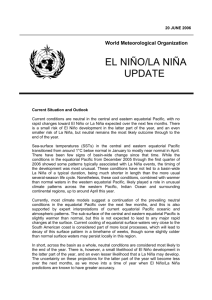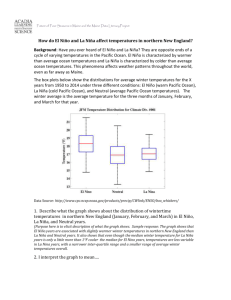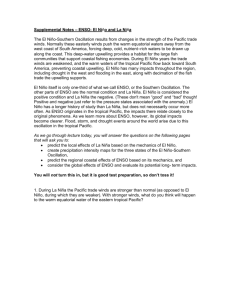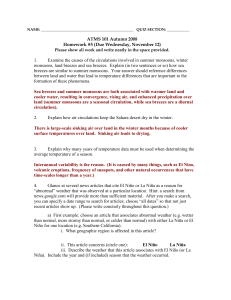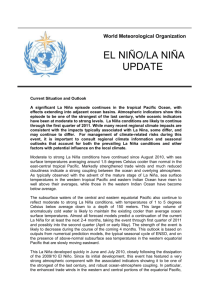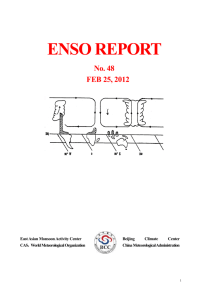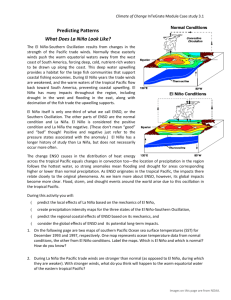March 2006
advertisement
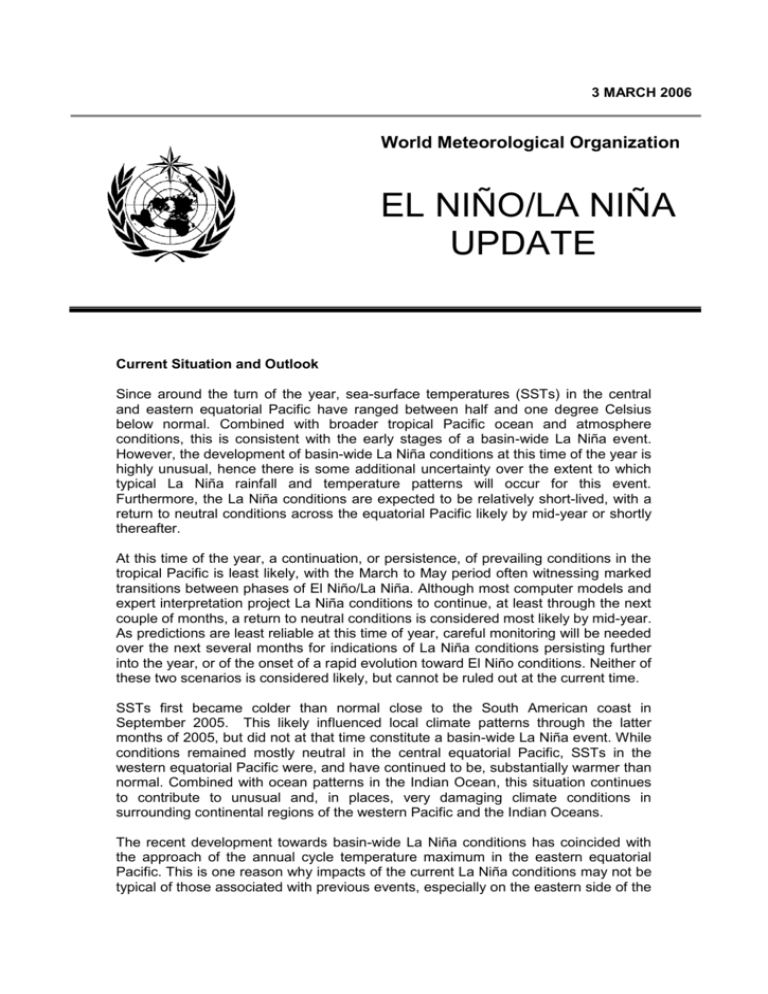
3 MARCH 2006 World Meteorological Organization EL NIÑO/LA NIÑA UPDATE Current Situation and Outlook Since around the turn of the year, sea-surface temperatures (SSTs) in the central and eastern equatorial Pacific have ranged between half and one degree Celsius below normal. Combined with broader tropical Pacific ocean and atmosphere conditions, this is consistent with the early stages of a basin-wide La Niña event. However, the development of basin-wide La Niña conditions at this time of the year is highly unusual, hence there is some additional uncertainty over the extent to which typical La Niña rainfall and temperature patterns will occur for this event. Furthermore, the La Niña conditions are expected to be relatively short-lived, with a return to neutral conditions across the equatorial Pacific likely by mid-year or shortly thereafter. At this time of the year, a continuation, or persistence, of prevailing conditions in the tropical Pacific is least likely, with the March to May period often witnessing marked transitions between phases of El Niño/La Niña. Although most computer models and expert interpretation project La Niña conditions to continue, at least through the next couple of months, a return to neutral conditions is considered most likely by mid-year. As predictions are least reliable at this time of year, careful monitoring will be needed over the next several months for indications of La Niña conditions persisting further into the year, or of the onset of a rapid evolution toward El Niño conditions. Neither of these two scenarios is considered likely, but cannot be ruled out at the current time. SSTs first became colder than normal close to the South American coast in September 2005. This likely influenced local climate patterns through the latter months of 2005, but did not at that time constitute a basin-wide La Niña event. While conditions remained mostly neutral in the central equatorial Pacific, SSTs in the western equatorial Pacific were, and have continued to be, substantially warmer than normal. Combined with ocean patterns in the Indian Ocean, this situation continues to contribute to unusual and, in places, very damaging climate conditions in surrounding continental regions of the western Pacific and the Indian Oceans. The recent development towards basin-wide La Niña conditions has coincided with the approach of the annual cycle temperature maximum in the eastern equatorial Pacific. This is one reason why impacts of the current La Niña conditions may not be typical of those associated with previous events, especially on the eastern side of the -2- basin. These unusual factors emphasize the importance of considering regionally and locally specific seasonal climate forecasts provided by National Meteorological and Hydrological Services, and information on expected conditions should not rely solely on the presence of El Niño or La Niña. In summary: Much of 2005 saw neutral conditions across the tropical Pacific, with no substantial swings toward basin-wide El Niño or La Niña conditions. The last few months of 2005 saw localized cooling close to the South American coast, sufficient to influence local climate patterns, but not widespread enough to constitute a basin-wide La Niña. The unusually cold surface waters that then spread to the central equatorial Pacific, combined with complementary atmospheric changes across the basin, have led to conditions that resemble the early stages of a basin-wide La Niña. It is unprecedented in the historical record for a La Niña of substantial intensity or duration to develop so early in the year. In view of the unusual timing of this La Niña development, caution is urged against inferring tendencies towards the typical weather patterns around the world associated with La Niña events. In the present configuration of the climate patterns, the caution against general inferences is most applicable to the eastern side of the basin, while the western side of the basin continues to show conditions more typical of La Niña. Most models and expert interpretations favour the event dissipating quite rapidly over the next 3 to 6 months. Nonetheless, neither a continuation of La Niña beyond mid-year nor the development of El Niño in the second half of 2006, can be ruled out as possible outcomes from the current prevailing conditions. The situation in the tropical Pacific will continue to be carefully monitored. More detailed interpretations of regional climate fluctuations is being generated routinely by the climate forecasting community and will be made available through National Meteorological and Hydrological Services. Climate Patterns in the Pacific Research conducted over recent decades has shed considerable light on the important role played by interactions between the atmosphere and ocean in the tropical belt of the Pacific Ocean in altering global weather and climate patterns. During El Niño events, for example, sea temperatures at the surface in the central and eastern tropical Pacific Ocean become substantially higher than normal. In contrast, during La Niña events, the sea surface temperatures in these regions become lower than normal. These temperature changes are strongly linked to major climate fluctuations around the globe and once initiated, such events can last for 12 months or more. The strong El Niño event of 1997-1998 was followed by a prolonged La Niña phase that extended from mid-1998 to early 2001. The El Niño -3- phase of 2002-2003 was not as strong as that in 1997-1998. El Niño events change the likelihood of particular climate patterns around the globe, but the outcomes of each event are never exactly the same. Furthermore, while there is generally a relationship between the global impacts of an El Niño event and its intensity, there is always potential for an event to generate serious impacts in some regions irrespective of its intensity. Forecasting and Monitoring the El Niño/La Niña Phenomenon The forecasting of Pacific Ocean developments is undertaken in a number of ways. Complex computer models project the evolution of the tropical Pacific Ocean from its currently observed state. Statistical forecast models can also capture some of the precursors of such developments. Expert analysis of the current situation adds further value, especially in interpreting the implications of the evolving situation below the ocean surface. All forecast methods try to incorporate the effects of oceanatmosphere interactions within the climate system. The meteorological and oceanographic data that allow El Niño and La Niña episodes to be monitored and forecast are drawn from national and international observing systems. The exchange and processing of the data are carried out under programmes coordinated by the World Meteorological Organization. Acknowledgements This El Niño/La Niña Update has been prepared as a collaborative effort between WMO and the International Research Institute for Climate and Society (IRI) as a contribution to the United Nations Interagency Task Force on Natural Disaster Reduction. It has been prepared based on contributions from the Australian Bureau of Meteorology (BOM), Centro Internacional para la Investigación del Fenómeno El Niño (CIIFEN), China Meteorological Administration (CMA), European Centre for Medium Range Weather Forecasts (ECMWF), International Research Institute for Climate and Society (IRI), Japan Meteorological Agency (JMA), Korea Meteorological Administration (KMA), Met Office United Kingdom, Météo France, National Institute of Water and Atmospheric Research (NIWA) in New Zealand, and United States Climate Prediction Center (CPC).
